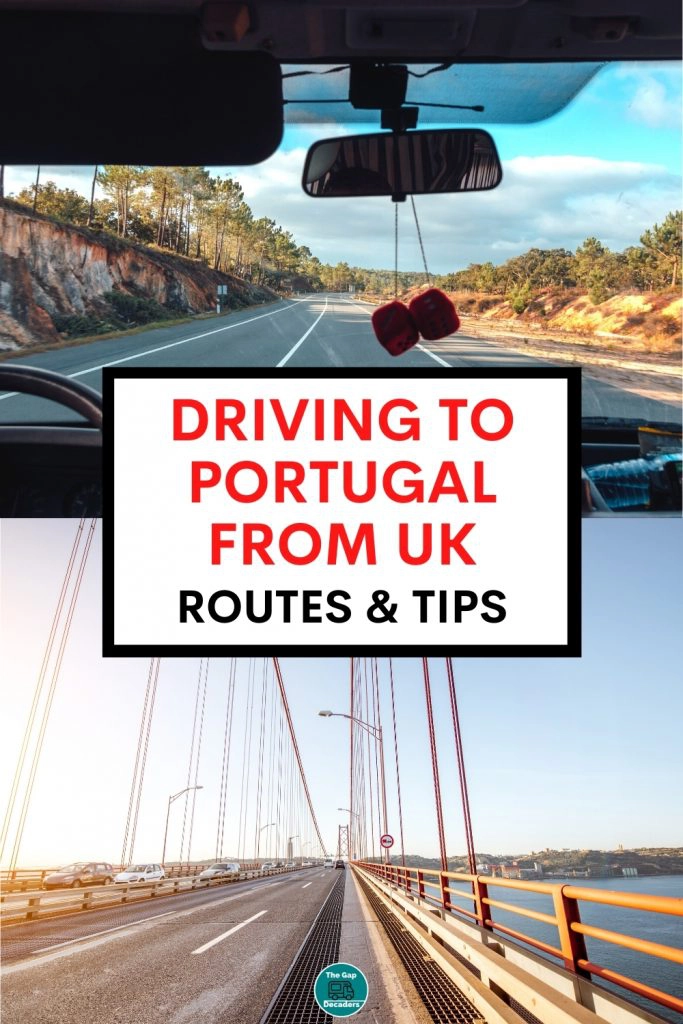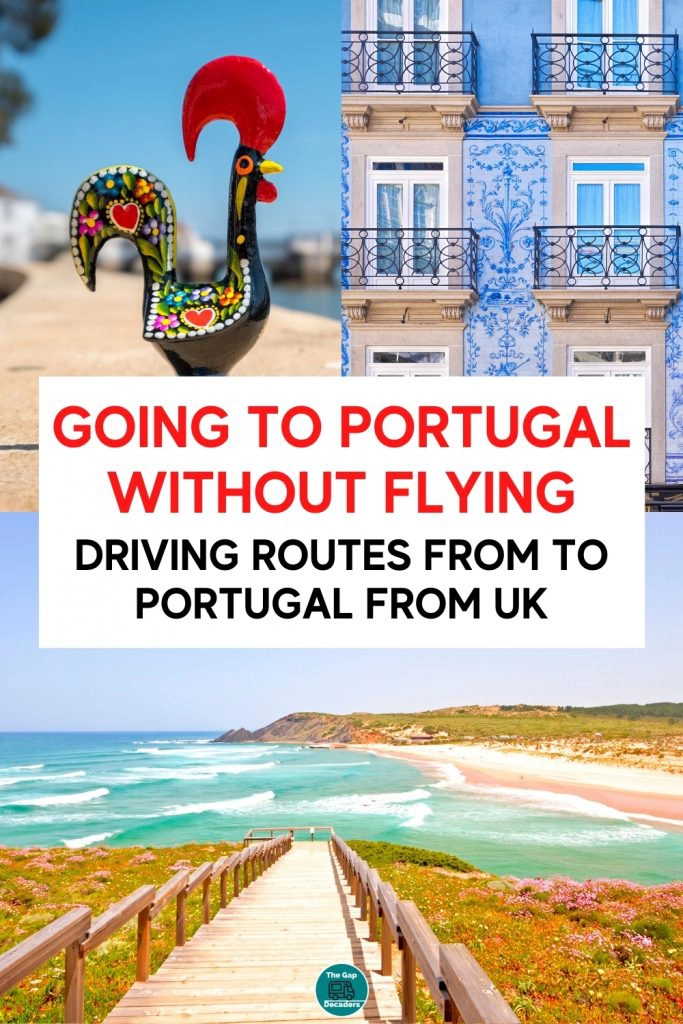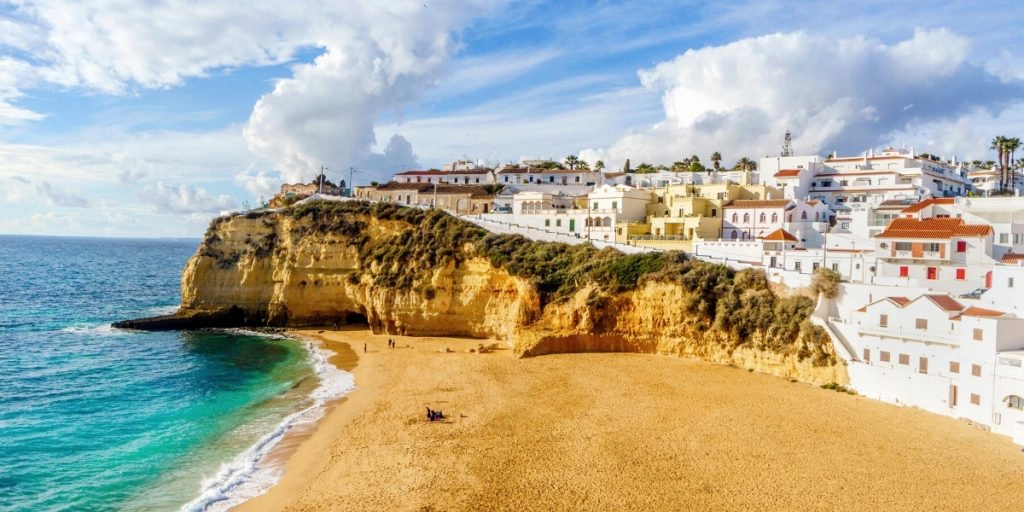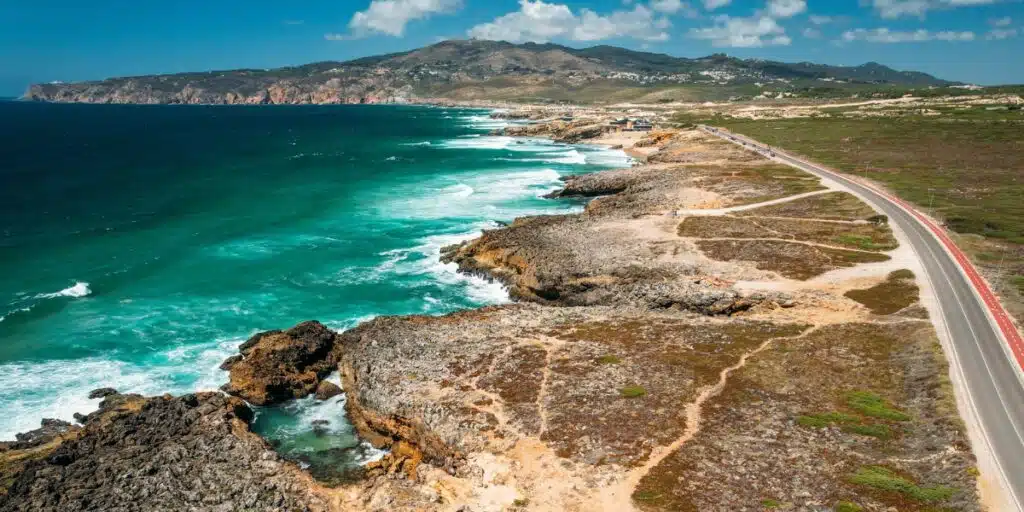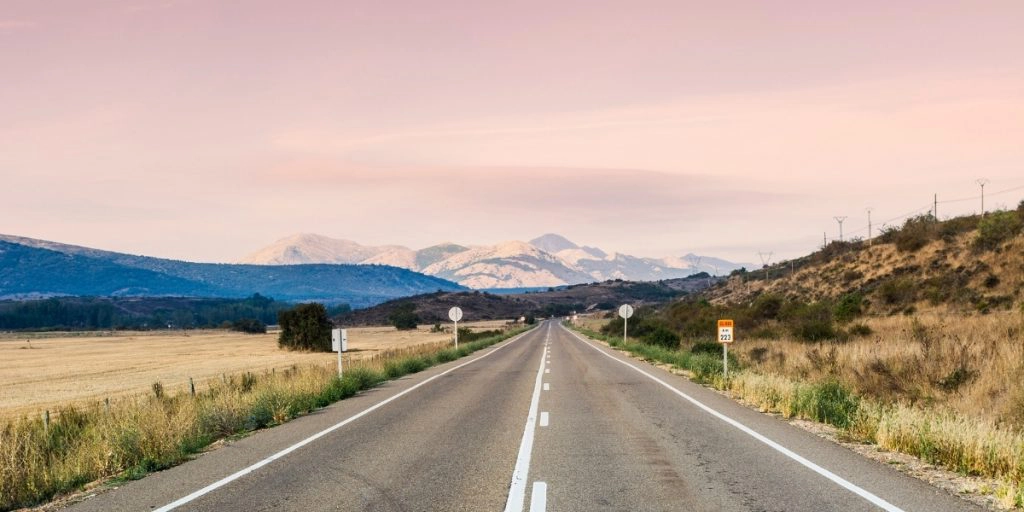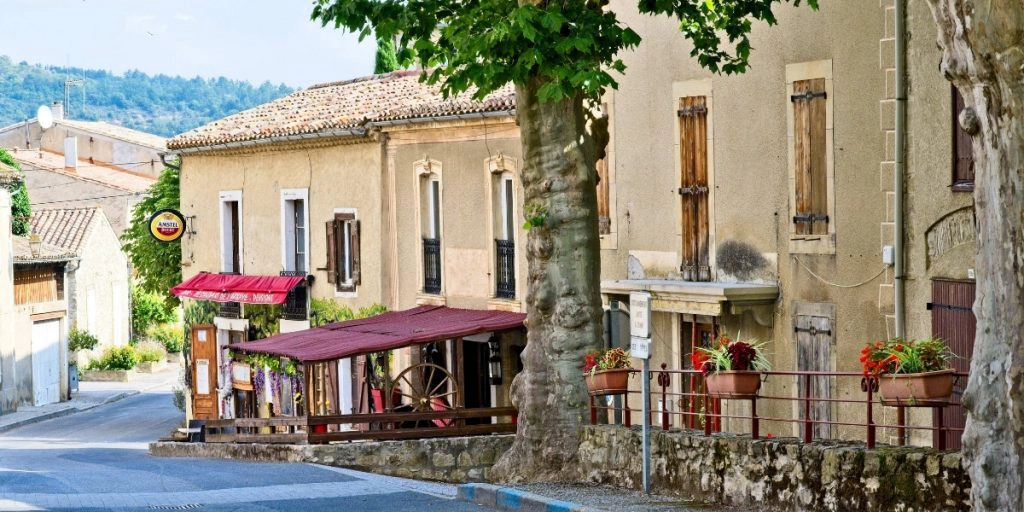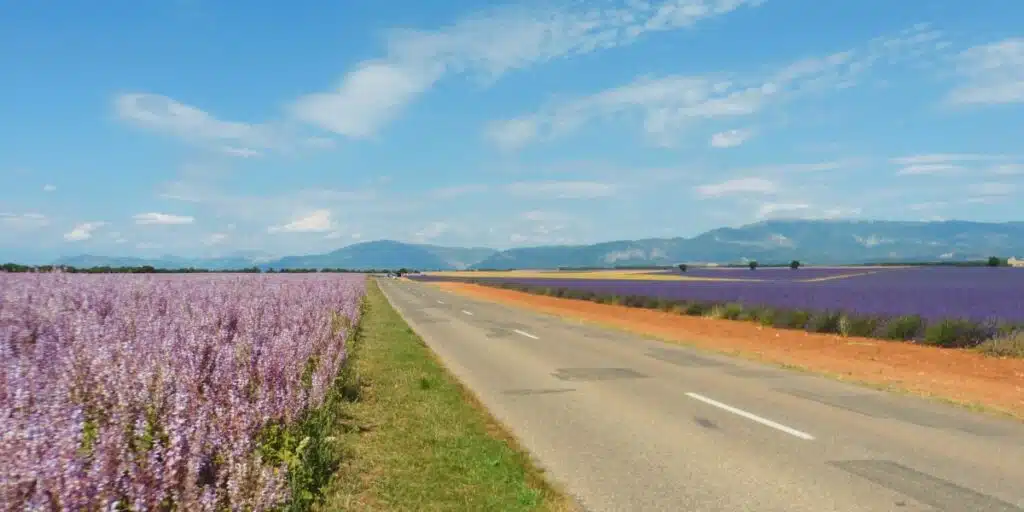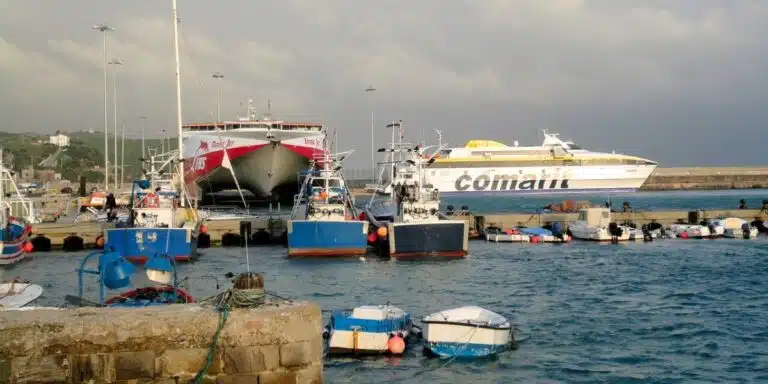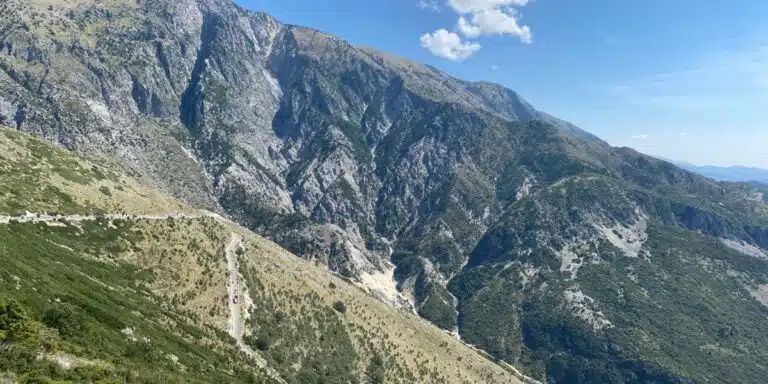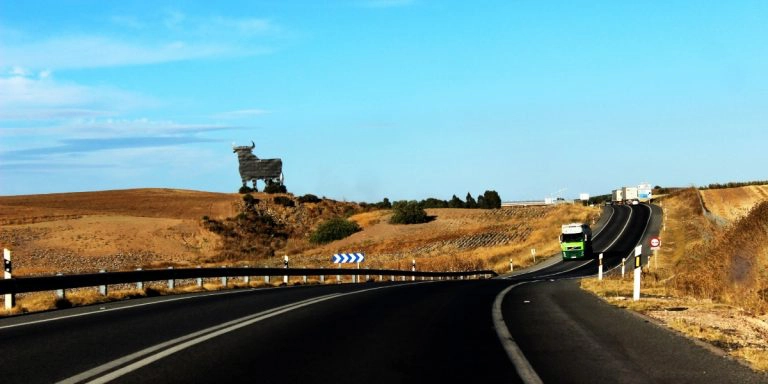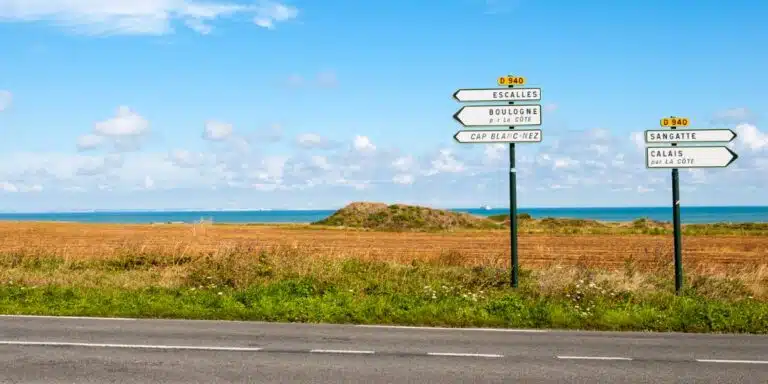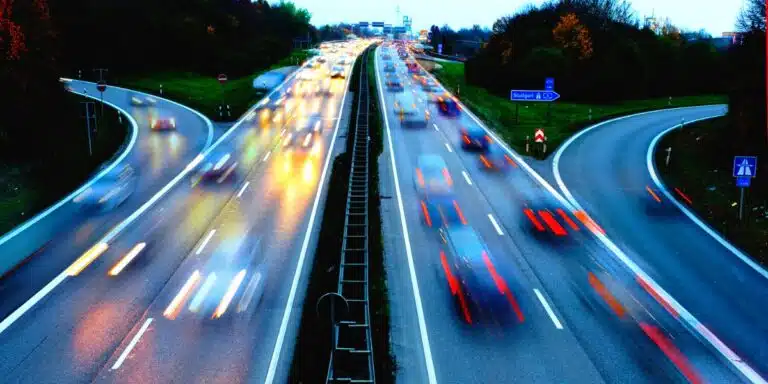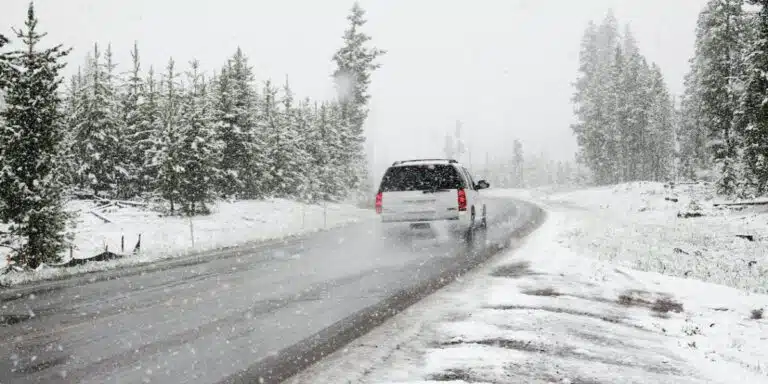This post may contain affiliate links, from which we earn an income. Click here to read our affiliate policy.
The Best Routes to Portugal from the United Kingdom
Are you desperate for some Portuguese sun but don’t want to fly? With great routes across Europe, it’s easy to drive to Portugal by car, arriving refreshed and unstressed from the comfort of your own vehicle.
With information about routes, maps, costs and comparisons, plus ferries to Europe and tips about driving once you’re there, our driving to Portugal from UK guide will help you decide which is the best route for your driving trip to Portugal, so you can arrive refreshed and ready to go!
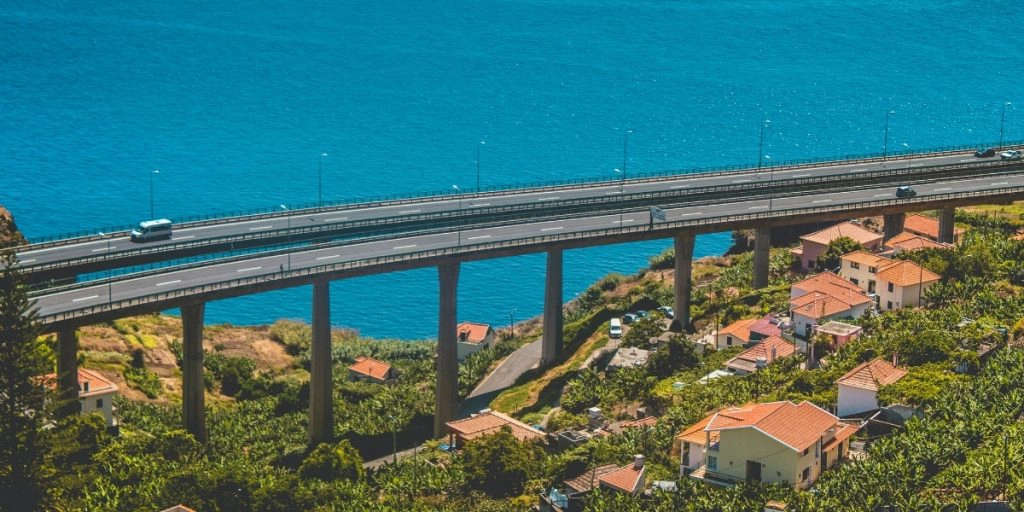
Crossing the Channel
EuroTunnel Le Shuttle
The fastest route is using the Eurotunnel Le Shuttle to Calais from Folkstone. The crossing under the channel takes 35 minutes, and with a quick check in and loading / unloading process, you can be in France proper within an hour.
This crossing is ideal if you are driving to Portugal from UK with a dog, or just want to get to the other side as quickly as possible.
Dover to Calais
Certainly the quickest way by ferry is the Dover-Calais route, on which both P&O and DFDS operate up to 40 crossings between them a day in July and August. Taking just 90 minutes, you’ll have time on board for a meal or drink, and perhaps a quick snooze.
Getting on and off can take time, as they have to piece all the vehicles together like a jigsaw puzzle. It’s not as quick as the shuttle, but very possibly cheaper, especially if you can be flexible with crossing times and want to break your time in the car.
Portsmouth to Caen / Cherbourg
More expensive and quite a bit longer than the Dover-Calais route, the Brittany Ferries crossings from Portsmouth to north-west France may prove to be cost effective in fuel and toll costs if you don’t live in the south east of England.
The Caen route operates three crossings a day, one of them overnight, meaning you’ll arrive in France refreshed and ready for a full day’s driving. You do have to book a cabin or reclining seat for the overnight crossing.
The Cherbourg route crosses at least 12 times a week and uses a fast catamaran service, taking just three hours port to port.
Other Popular Crossings
There are a handful of other routes out of Newhaven, Folkestone and Poole which are also worth exploring. You could also consider sailing to Le Havre or St Malo from Portsmouth, or Dunkirk from Dover.
The key here is to to be flexible with dates and times to get the best deals …this is where you may just find a bargain.
England to Spain
One of the simplest ways of getting to Spain is to miss France altogether and get a ferry to Spain from UK, sailing from Portsmouth or Plymouth to Santander or Bilbao in northern Spain.
The UK to Spain ferry crossings take a long and boring 24 hours, books up quickly and can be expensive, even taking into account the costs of tolls and fuel in France.
However, if you don’t enjoy driving, have a pet with you or just want to take things a little more slowly, then taking one of the ferries from the UK to Spain may well be the best option.
UK to Portugal Ferry
Sadly, there is no direct ferry to Portugal from the UK.
Brittany Ferries looked at a running a ferry route from Plymouth to Porto in northern Portugal in 2021 during the pandemic but determined that it was not a commercially viable route for them.
Is this your first time visiting Portugal? Get all the information you need in our Portugal Travel Guide, including what to pack, the best time of year to go, getting there and practical tips to help you have the best trip!
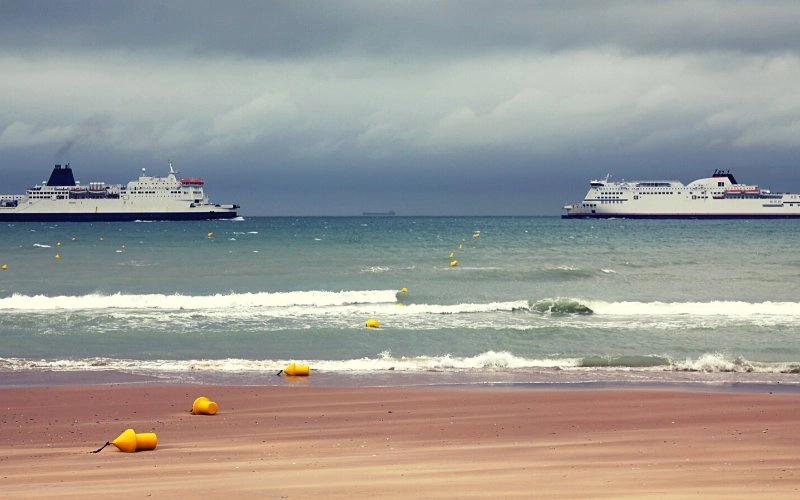
Driving in Europe
Driving to Portugal from UK means observing the driving rules and regulations of three countries, France, Spain and Portugal itself.
That means you’ll need different kit and equipment in each country when you travel in Europe – sigh – but happily lots of the basic travel and road laws in each country are the same;
- You must have at least three months remaining on your passport (issued in the past ten years) at your intended date of departure from Norway.
- You must have at least 3rd party insurance for your vehicle. Update August 2021 – you no longer require a green card to prove you have vehicle insurance cover when travelling in Europe.
- From 28th September 2021, you will have to display a UK sticker on the rear of of your vehicle, instead of a GB sticker, unless you have a new style UK numberplate which displays the Union Jack flag.
- Your headlights must be adapted for driving on the right.
- Your UK licence allows you to drive in all EU countries. If you only have a paper driving licence or a licence issued in Gibraltar, Guernsey, Jersey or the Isle of Man then you will need an International Driving Permit.
- We recommend that you carry an EHIC/GHIC card for medical emergencies and take out travel insurance as well, which will cover you should you need to be medically evacuated or require complex ongoing treatment. We recommend True Traveller.
- You may also want to take out European breakdown cover for your trip.
- All three countries you’ll be travelling through have strict drink driving laws compared to UK. The UK maximum is 0.8 mg/ml and the French, Spanish and Portuguese maximum is 0.5 mg/ml of alcohol per litre in your blood. If you are tested and found to be over the limit, you may face up to 4,500 euros fine and have to appear in court.
RELATED POST: Driving in Europe – Everything You Need to Know
Driving in France
Driving from UK to France and through the country is easy, with well maintained roads and generally considerate and well-mannered drivers.
On the downside, France is one of the most expensive countries in which to drive in Europe, due to the high fuel costs and expensive tolls, especially if you’re travelling in a larger vehicle like a motorhome.
There can also be regular disruptions and fuel blockades due to political tensions, so make sure you check the current situation when you leave home.
Follow these tips for a safe and easy transit through France on your road trip to Portugal from England.
- In recent years there has been a significant increase in speeding fines issued by French authorities to Brit drivers. Many get home from a holiday or road trip to a nasty surprise in the post. Be aware and stick to the speed limits when driving in France …and Spain and Portugal too.
- You must carry at least one reflective jacket within the passenger compartment of your vehicle and must put it on before you get out in an emergency or breakdown situation.
- You must also carry a warning triangle.
- On 1 November 2021 the Loi Montage II or ‘mountain law II’ came into force in 48 French mountainous departments within the Alpes, Massif Central, Jura, Pyrenees, and Vosges regions. Anyone travelling in a car or motorhome or through one of these areas between 1 November and 31 March will be obliged to fit four approved winter tyres or carry at least two snow chains or socks in the vehicle.
- From 1st January 2021, all vehicles over 3,500kg are required to display infographic ‘angles morts’ or blind spot stickers. Stickers must be visible on both sides and at the back of the vehicle and must be placed between 0.90m and 1.50m above the ground. Stickers must be placed in such a way that they don’t cover the vehicle’s regulatory plates and inscriptions, any of the lights or signals, and don’t hinder the driver’s field of view.
- As of January 2013 the French government announced that the introduction of an €11 fine for not carrying a breathalyser/alcohol test had been postponed indefinitely. However, law still states that drivers must have an alcotest ready for use in their vehicle even though no penalty will be imposed if they cannot present one during a police road check.
Tolls in France
You may want to consider carrying an Emovis electronic toll pass which deducts the fees from a credit card automatically, meaning you don’t have to stop at a booth or barrier. This will also cover you in Spain and Portugal.
Motorway Breakdowns in France
French motorways are privately managed and you’re not allowed to request your own assistance company to attend to you if you break down.
If you do break down, you should use the orange emergency telephones that are situated every 2km along French motorways to call the police or the official breakdown service operating in that area. Alternatively, if no orange telephone is available, you should call the emergency services by dialling 112.
You will be towed to a safe designated area where you can make onward arrangements for your own breakdown insurer to assist you. If you don’t have breakdown insurance, the towing company will be able to provide support or signpost you.
Charges for assistance on a motorway are fixed by the government and are reviewed and revised each year. Many of the government-appointed towing services allow large insurers to pay them directly, but this is at their discretion and will depend on who your breakdown cover is with. If this is not the case, you should pay directly and then seek recompense from your insurer.RELATED POST: Road Trip on a Budget: 36 Tips to Save Money in Europe
Driving in Spain
Spanish roads are typically well maintained, the drivers considerate and relaxed. Some of the best roads in Spain are in the interior, where you will have long stretches of sweeping autopista (motorway) and autovía (dual carriageway) to yourself.
You find fuel around 20% cheaper than France and the UK and tolls very reasonably priced, if not free of charge. Follow our guide and tips for safe driving in Spain;
- You must carry two warning triangles for front and rear. These warning triangles are now being phased out and from 1st July 2021 a new law requires that a V16 flashing emergency light is used, although both means of advising other traffic will be legal until the end of 2024.
- From 28th September 2021, even if you have a new style UK numberplate, you need to display a UK sticker on the rear of your vehicle when driving in Spain.
- You must also carry a reflective jacket for the driver and all passengers.
- You must carry a spare wheel and the tools to change a wheel, or a tyre repair kit.
- If you wear glasses you must also carry a spare pair.
- The use of winter tyres in Spain is regional. Look out for traffic signs indicating that winter tyres or snow chains are compulsory where you are.
- Anything with a screen (television, video, DVD etc.) which could distract you when driving should be positioned where you can’t see it. This doesn’t apply to a sat nav but you must not touch or program your sat nav unless parked in a safe place.
- Using radar detection equipment is prohibited under Spanish law and new regulations from January 2021 mean that it will also be illegal to be in possession of such equipment.
- On roads with single carriageways, the speed limit established may not be exceeded by more 20 km/h when overtaking.
RELATED POST: 19 Helpful Long Distance Driving Tips
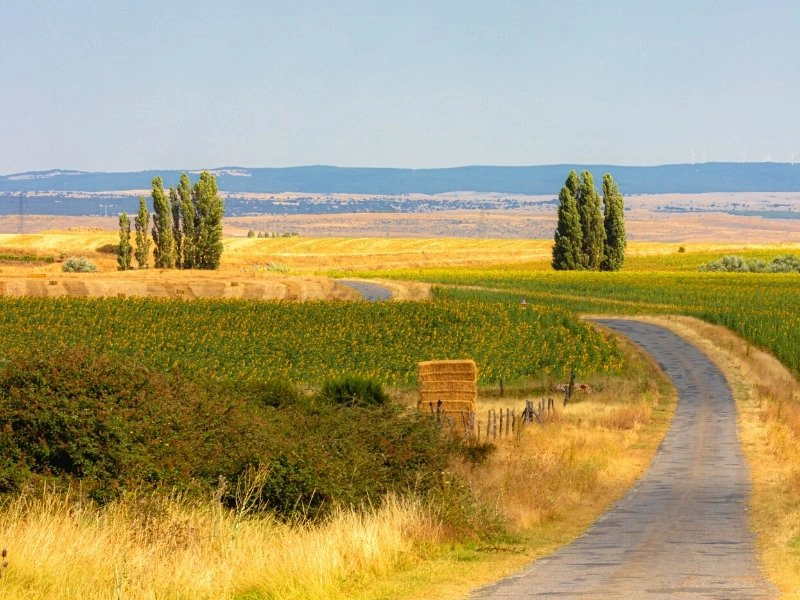
Route Planner – France & Spain to Portugal
The Quickest Driving Route from UK to Portugal
Rouen – Le Mans – Tours – Bordeaux – Irun – Valladolid – Braganca
All routes assume travel from Calais in a 2 litre petrol car. Use this route planner to find your costs.
“How long to drive to Portugal?” is a common question. Whether you cross into Calais, Caen or Cherbourg, the quickest road to Spain and then Portugal is down the western side of France.
You’ll miss the major high ground in the middle of France and be able to travel on autoroutes pretty much all the way. From Calais, head for Rouen, then Le Mans, Tour, Bordeaux and down to the border at Irun. From there it’s a diagonal hop via Valladolid into the top north-eastern corner of Portugal near Braganca, and then an easy drive to the fabulous city of Porto.
For those arriving by boat to Caen or Cherbourg, head for Le Mans and pick up the remainder of the route there.
You could get to Portugal in a day if you were sharing the driving, but we would suggest a stop in Bordeaux if coming from Calais. If you’re coming from Caen or Cherbourg, anywhere near the France-Spain border makes a good stop.
The Most Scenic Route
Paris – Orleans – Clermont-Ferrand – Millau – Perpignan – Barcelona – Zaragoza – Burgos – Valladolid – Braganca
Driving from UK to Portugal by car doesn’t have to be boring. This route will take you through some of France’s most spectacular scenery and across the Massif Central.
From all the ports, head for the Paris ring-road and follow your sat nav carefully …you really don’t want to end up in inner city Paris! Perhaps stop off, find a good hotel and take in one of the most beautiful cities in the world before heading south.
Next up is Orleans on the banks of the Loire river and home to Joan of Arc. From here, head south to Clermond-Ferrand, surrounded by dramatic extinct volcanoes and authentic French countryside villages, perfect for a few days walking before you hit the road again. Make for Millau and cross the highest road bridge in the world en route, the incredible Millau Viaduct.
Your nest stop is Beziers, home to the Canal Du Midi and its’ famous nine locks. This often overlooked city makes a great pit stop. Finally, you’ll reach pretty Perpignan where you can enjoy the last of France before crossing the border for the drive to Barcelona, the perfect city in which to stop for a day.
From Barcelona head west across the Meseta high plateau of Castile and Leon, where castles perch on rocky outcrops and snow-capped mountains beckon in the distance. This sparsely populated part of Spain was the springboard from which the Christian reconquest of Spain spread southwards, and you can see the history in every town along your route.
You will be able to find great hotels in all these destinations, allowing you to enjoy a slower pace and see some off the beaten track France, or to follow a Spanish road trip route.
Perhaps take the scenic route to Spain and take the fast route for the return journey, when you’ll be looking forward to getting home.
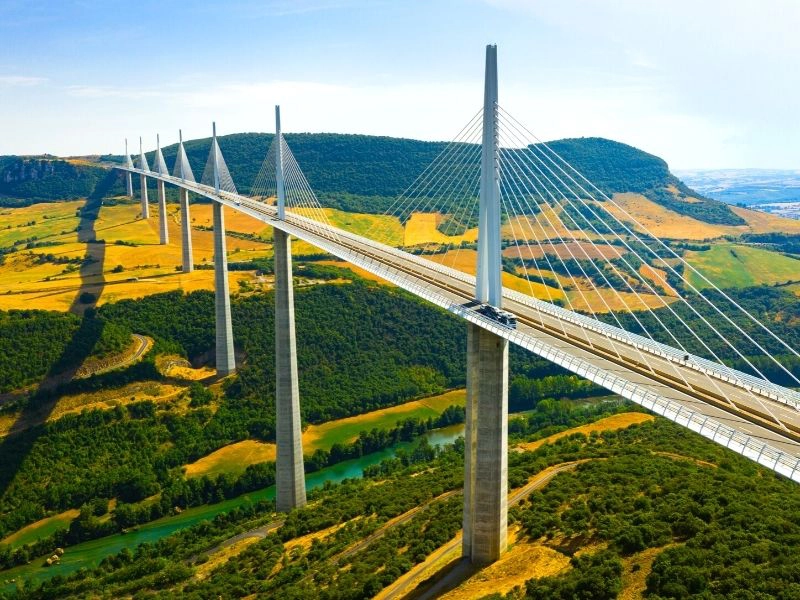
The Cheapest Route
Rouen – Chartres – Poitiers – Bordeaux – Irun – Valladolid – Braganca
Driving to Portugal from UK avoiding tolls is very possible. You will still travel down the western side of France, with the route relying heavily on the A28 and N10 toll free roads.
Once into Spain, the total toll cost taking you into Portugal is just €20.
Not all stretches in France are dual carriageway and you risk slow moving vehicles, and traffic jams, especially on the approach to larger cities – it’s likely to take longer than the stated 18 hours.
RELATED POST: Road Trip on a Budget: 36 Tips to Save Money in Europe
Road Trip Ideas
Onward Portugal Travel
Portuguese roads around cities and major towns are generally well maintained, although this is not always the case in rural areas.
Drivers in Portugal have a bad reputation, not always fairly so, although the proper use of roundabouts and indicators seems to elude most! Our Portugal driving and travel tips will help you stay safe on your road trip;
- You must carry photographic proof of ID when you travel in Portugal by road.
- You must also carry a reflective jacket for the driver and all passengers.
- It is recommended that you carry a warning triangle.
- It is forbidden to use a dash cam or radar detector in Portugal.
- You will see Portuguese drivers using mobile phones at the wheel frequently but this this is actually illegal, despite appearances to the contrary.
- If you are driving in a large town or city, then ‘helpers’ will wave you to spaces or car-parks in the hopes of getting a tip. Clearly you do not have to tip them unless you feel it’s deserved. When you are hot and stressed and trying to park, having someone waving at you and ‘helping’ is not always that helpful!
- Portugal has one low emission zone (LEZ) in Lisbon, which was introduced in the inner city centre in 2011. In 2012, a large area was added to the LEZ, which now comprises two sub-zones and currently covers 33% of the whole city. Click here for more information.
RELATED POST – One Day Lisbon Itinerary with Map & Tips
Toll Roads in Portugal
Toll roads in Portugal are complicated! There are a number of different companies requiring different systems, with options to pay electronically or pre-pay. It is often not possible to pay as you go. This site provides a good explanation of them all.
Having spent quite a bit of time touring in Portugal, we think the temporary Via Verde device is the best option. This is an electronic device you can order online in advance. It’s valid throughout all the Portuguese highways network, highways with electronic-only tolls and designated lanes on traditional tolls.
Where possible though, avoid the tolls and take the scenic route when driving around Portugal, you’ll have a much better experience.
However you decide to drive to Portugal, have a safe trip and enjoy your holidays!
Are you looking for more road trip resources? Check out these top posts
Ferry from Spain to Morocco: Best Options & Top Tips
Driving in Albania: Essential Tips for an Amazing Trip
Driving to Spain from UK: Best Routes & Driving Tips
Driving to France from UK: Absolutely Everything You Need to Know
Driving from UK to Germany: Best Routes, Costs & Tips
Tips for Stress-Free Holiday Road Trips with Your Family
Love it? Pin it!
